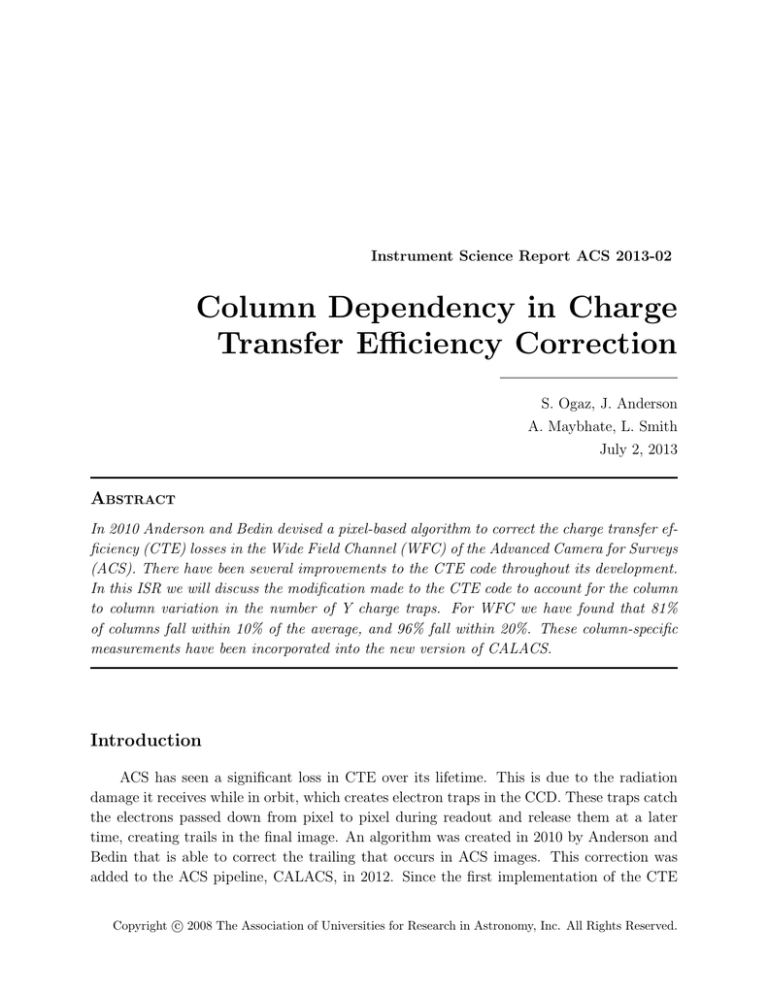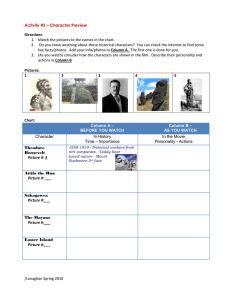
Instrument Science Report ACS 2013-02
Column Dependency in Charge
Transfer Efficiency Correction
S. Ogaz, J. Anderson
A. Maybhate, L. Smith
July 2, 2013
ABSTRACT
In 2010 Anderson and Bedin devised a pixel-based algorithm to correct the charge transfer efficiency (CTE) losses in the Wide Field Channel (WFC) of the Advanced Camera for Surveys
(ACS). There have been several improvements to the CTE code throughout its development.
In this ISR we will discuss the modification made to the CTE code to account for the column
to column variation in the number of Y charge traps. For WFC we have found that 81%
of columns fall within 10% of the average, and 96% fall within 20%. These column-specific
measurements have been incorporated into the new version of CALACS.
Introduction
ACS has seen a significant loss in CTE over its lifetime. This is due to the radiation
damage it receives while in orbit, which creates electron traps in the CCD. These traps catch
the electrons passed down from pixel to pixel during readout and release them at a later
time, creating trails in the final image. An algorithm was created in 2010 by Anderson and
Bedin that is able to correct the trailing that occurs in ACS images. This correction was
added to the ACS pipeline, CALACS, in 2012. Since the first implementation of the CTE
c 2008 The Association of Universities for Research in Astronomy, Inc. All Rights Reserved.
Copyright correction several improvements to the code have been made. One such improvement is a
column-based adjustment to the level of the CTE correction.
Because of the stochastic nature of trap creation in CCDs, we expect that some columns
will have more traps, and therefore more CTE losses, than other columns. This idea led to
a study of this variation in the hopes that we could get an accurate measure of CTE in each
column and feed that back into the correction algorithm. Measuring the difference in CTE
between columns was a somewhat delicate process. In order to be sure we were measuring
the column sensitivity due to a variation in the number of traps and not the variation in
signal, we needed images with a consistent and even signal level. We also needed to be able
to separate the counts from the CTE trails from the source counts. We were able to fulfill
both these requirements with ACS/WFC flat field images. This also allowed us to analyze
the column dependency over each year of ACS operation starting in 2002.
Data
Table 1 summarizes the flat field data that were used for this study. The high level of
counts and low variation in these frames mean that any difference in CTE trails comes from
a difference in the number of traps present. The actual pixels we used to measure the CTE
trails are located in the virtual overscan of the image. The virtual overscan of any image
contains only two sources of counts: the bias and CTE trails from the image area of the flat
fields. This makes these pixels an ideal place to measure trails. In addition, the trails in this
area are created by the image pixels furthest from the readout in the Y direction. These
pixels pass every trap present in the column during readout, making their trails an accurate
representation of the total number of traps in that column.
Figure 1 is a schematic of the top left corner of WFC2, and shows the exact pixels used
in our analysis. The bottom pixel of the virtual overscan region is the first pixel of the trail
from the image portion of the chip. As shown in Anderson & Bedin (2010) the trail drops
off steeply with distance from the initial flux pixel. For simplicity we take the first pixel of
trail as a measurement of the relative CTE trailing in each column. Figure 2 shows a cutout
of the virtual overscan portion of a WFC2 flat field image in ds9. The trails can be clearly
seen at the edge of the CCDs.
2
Year
2002
2003
2004
2005
2006
2007
2009
2010
2011
Number Median
of Flats of Pixels
11
21
18
6
6
3
5
15
6
48,932
49,719
49,456
49,170
50,986
59,636
60,264
60,126
60,058
Standard Deviation
of Pixels
7,347
7,409
7,369
7,325
7,370
8,737
9,005
8,982
8,980
Table 1: Number of flat files used for each year, along with the median and standard deviation
of all the pixels in all flats from one year. This table shows the low variation in the flat field
images.
Analysis
Figure 3 shows the average distribution about the average of bias-subtracted CTE-trail
first pixels six flat field images we have for the year 2009. We estimated the bias level
independently for each column by averaging the first 11 pixels of the virtual overscan region
(see Figure 1). This plot shows a clear correlation between column and CTE trail value. For
each column we took an average of all points in one year, using the standard deviation as
the error value. This average was then compared to the boxcar average of the surrounding
50 pixels (25 pixels to the left and right), and a normalized percent difference was taken.
Figure 4 shows this for a standard column in the WFC2 CCD, column 2603 for the years
2002 to 2011. For the years 2009 to 2012 the trail in column 2603 consistently falls at about
130% of the average.
We then condensed the data from all years into a single relative-CTE estimate for each
column. By visual inspection we determined that the trail values for years 2002 2007 had
large error bars and a large variation over time. This is expected as the column variations
due to CTE loses should not be significant over this time period, resulting in low signal to
noise. Therefore, to obtain our final values we took an average of the 2009 to 2011 data
points only.
3
Fig. 1.— Schematic of CCD 2 of WFC/ACS. The purple area is the science image and the
top blue area is the virtual overscan area. Each trail pixel has been bias subtracted using the
average of the bias pixels shown. Also shown are the range of pixels used to take a boxcar
average.
Fig. 2.— Cutout of a raw flat image, taken from the virtual overscan region of columns
2874-3020. White represents high intensity, black represents low intensity. At this stretch
it is possible to see the various amounts of trailing in the virtual overscan caused by the
varying number of traps in each column of the CCD.
Figure 5 gives our final results, with Figure 6 showing a close up of columns 2650 to
2700. 96% of the columns lie between 1.2 and 0.8 for both CCD chips on WFC, meaning a
typical column does not vary from the average by more than 20%. These final values scale
the level of CTE correction for each column with the number of traps in each column. The
extreme outliers (i.e. above 200% difference) have been confirmed as hot columns.
4
Fig. 3.— Column number versus the ratio of the trail in column 2603 to the boxcar average.
Data for each column is taken from the six 2009 flat images, so that each column is composed
of six data points.
In order to test the column correction, we ran the CTE correction, with and without the
column adjustment, on flats taken in 2012. These flats were not part of the original column
dependency measurement. The following files were used: jbwa07p6q, jbwa07p8q, jbwa07paq,
jbwa14efq, jbwa14ehq, jbwa14ejq. We processed each flat in the same way as the previous
flats, performing our own bias subtraction. Then each file was run through CALACS with
all processing steps set to OMIT except DQICORR and PCTECORR. The CTE correction
code has been adjusted so that it will run successfully on the virtual overscan regions of an
image. The virtual overscans were left in the image (since BLEVCORR was set to OMIT).
5
Fig. 4.— CTE trail strength for column 2603 for the years 2002 to 2012. The x-axis
represents the year and the y-axis represents the percent difference of the trail in column
2603 and the boxcar average, normalized to one. As the CCDs receive radiation over time,
the number of traps change, resulting in a change in the CTE trails.
Once we had two versions of the processed flats (one with the column correction enabled,
one with it disabled), we compared the first pixel of trail in the virtual overscan. This
comparison was done by fitting a line to the first pixel of trail for each column in all six
images and looking at the residuals of the fit. As the original column adjustments were done
with a boxcar average, we chose to do a linear fit to each amp individually. In theory, if
the CTE correction and bias correction were each done perfectly, we would be left with only
the read noise and the Poisson noise from the trails. In practice, the CTE correction, with
or without the column correction, is designed to err on the side of under-correcting, rather
then over-correction. As such there will always be a small percentage of flux left in the trail
(Úbeda and Anderson, 2012). Table 2 shows the results of the fits. Unfortunately, we did
not have enough data to get significant statistics. The column and non column corrected
files have approximately the same residuals.
6
Fig. 5.— Final column to column variation for WFC2. These points are the average of the
values calculated from 2009 2011. The error bars represent the standard deviation of the
measurements taken from each flat field added in quadrature. All outlier values have been
confirmed as hot columns.
7
Fig. 6.— An enlargement of Figure 5 showing columns 2650 to 2700.
Amp
Linear Fit
w/o Column Corr
Residuals
w/o Column Corr
Linear Fit
w/ Column Corr
Residuals
w/ Column Corr
A
B
C
D
−1.55×10−2 x + 155
1.54×10−2 x + 171
−0.97×10−2 x + 192
4.94×10−2 x + 108
2.13×109
1.52×109
7.85×107
1.09×1010
−1.67×10−2 x + 158
1.50×10−2 x + 172
−0.90×10−2 x + 192
5.02×10−2 x + 107
2.16×109
1.51×109
8.02×107
1.09×1010
Table 2: The linear fits and the sum of the residuals for each amp post CTE correction. One
set of files has the column correction enabled, one had the column correction disabled. The
fits and residuals are in units of electrons.
8
Conclusions
This CTE trail column dependencies described here have been implemented in CALACS
as a look up table in the pctetab pcte.fits file. The final values get applied as multiplier to
the CTE correction, with 1.0 producing no change in the strength of the correction. 96%
of the columns lie between 1.2 and 0.8 for both CCD chips on WFC. Values higher than
2.0 were considered to be outliers and set to 1.0. Overall, this study has shown that the
variation in the number of traps in each column has a small overall effect on the amount of
CTE trailing in an image. The ACS team will continue to monitor the column dependency
of the CTE trails and improve the accuracy of the CTE correction.
Acknowledgments
We would like to thank the ACS Team for their help and input. We would also like
to thank Matt Davis, Pey-Lian Lim, and Warren Hack for their help with our CALACS
questions.
References
Anderson, J., & Bedin, L. 2010, PASP., 122, 1035
Úbeda, L., & Anderson, J. 2012, Instrument Science Report ACS 2012-03 (Baltimore: STScI)
9




